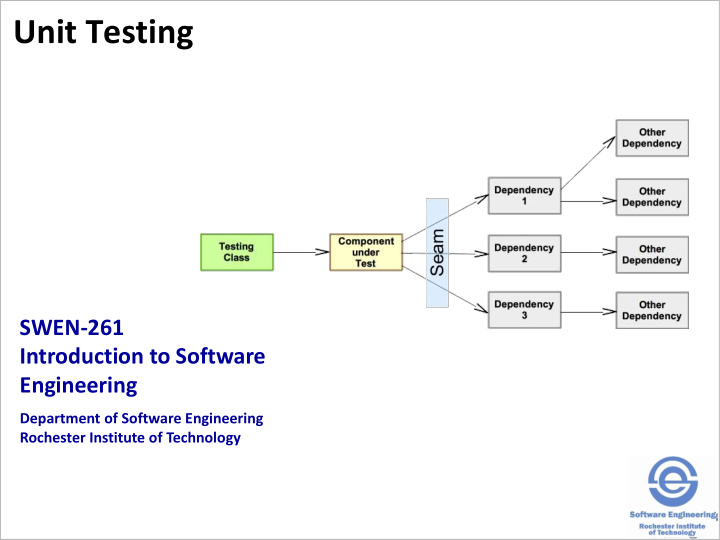



Unit Testing SWEN-261 Introduction to Software Engineering Department of Software Engineering Rochester Institute of Technology
There are many levels of software testing. The developer of the software has the sole responsibility for creating and verifying unit tests. https://insights.sei.cmu.edu/sei_blog/2013/11/using-v-models-for-testing.html 2
The scientific method that you studied in your physics courses is not just for science! ▪ Software testing and debugging is experimentation using the scientific method • Make a hypothesis Your software executes per the requirements A certain place in your code is responsible for a bug • Create an experiment to test the hypothesis Write unit tests Determine the scenario that triggers the bug and set breakpoints where you think the bug arises • Run the experiment Run the unit tests Run the system to the breakpoint • Analyze the results to decide if the hypothesis is true If unit tests pass, the hypothesis is true If the problem is seen, you have found the bug location 3
These are the essential characteristics that should be your goals when you write unit tests. ▪ Automatic ▪ Thorough ▪ Repeatable ▪ Independent • Test only one thing at a time • Tests should not depend on each other ▪ Professional • Readable • Use standard OO principles ▪ Fast • Using Maven, unit tests are run on each build 4
This is the checklist of items that you should ensure get tested by a class' unit tests. ▪ Business logic • Tests for each path through a method • Happy path as well as failure paths ▪ Constructors and accessors ▪ Defensive programming checks • Validation of method arguments NullPointerException IllegalArgumentException • Validation of component state IllegalStateException ▪ The equals and hashCode methods, as needed ▪ Exception handling 5
Here's the typical formula for a test. ▪ Create a test class for each component under test (CuT) that has privileged access to the component. • In Java, the test code typically has package access. ▪ Create a test method that covers each happy and failure scenario. • Setup test scenario • Invoke the test • Analyze the test results ▪ This simple formula can be adjusted as needed. ▪ Note: see the after-class exercise for more detailed instructions for unit testing with JUnit, Mockito, and Maven along with examples from the GuessGame unit tests. 6
Unit testing frameworks like JUnit have many built-in assertions for analysis in your tests. ▪ Test truth-hood • assertTrue(condition[, message] ) • assertFalse(condition[, message] ) ▪ Test values or objects for equality • assertEquals(expected, actual[, message] ) • assertNotEquals(expected, actual[, message] ) ▪ Test objects for identity ( obj1 == obj2 ) • assertSame(expected, actual[, message] ) • assertNotSame(expected, actual[, message] ) ▪ Test null-hood • assertNull(object[, message] ) • assertNotNull(object[, message] ) ▪ Automatic failure: fail(message) 7
One tip for coding for testability is to make strings and constants available to the unit test. ▪ Idioms for testable code: • Make message strings (and other values) constants • Make these members package-private (or public) ▪ Example: public class GameCenter { final static String NO_GAMES_MESSAGE = "No games have been played so far."; final static String ONE_GAME_MESSAGE = "One game has been played so far."; final static String GAMES_PLAYED_FORMAT = "There have been %d games played."; public synchronized String getGameStatsMessage() { if (totalGames > 1) { return String. format ( GAMES_PLAYED_FORMAT , totalGames); } else if (totalGames == 1) { return ONE_GAME_MESSAGE ; } else { return NO_GAMES_MESSAGE ; } } 8
To write an "independent" unit test of a class, you will need to control the dependencies. ▪ Most components will have dependent classes • Stored as attributes • Passed in as arguments ▪ This coupling forms a "seam" between the component under test and it's dependencies: ▪ Use dependency injection rather than direct instantiation. 9
Isolate the CuT by injecting friendly and mock objects. ▪ Fully tested internal components (usually Model objects like Entities and Value Objects) ▪ Mock objects that stand in for internal or external components ▪ There are other variations on test instruments: Spy, Dummy, Fake, Simulator. 10
Mock object frameworks like Mockito have APIs for setting up test scenarios and inspecting results. ▪ Setting up test scenarios • Specify the response, e.g. return value or exception thrown, when a method is called on a mock object • when (mock.method(args)). thenReturn (value) ▪ Verify that interactions occurred during a unit test • Check if methods were called the expected number of times in the manner expected • verify (mock, times (1)).method(args) ▪ Answer objects that allow you to capture and later test intermediate results of unit test 11
Make unit testing part of your project's Definition of Done and your quality will rise! ▪ Unit testing is a subtle art. ▪ Keep your test code isolated from production code. ▪ Use the testing formula: arrange, invoke, analyze. ▪ Use an Assertion library like JUnit. ▪ Use a Mock object framework like Mockito. ▪ See after-class exercise for more detailed examples of doing unit tests with JUnit, Mockito, and maven. 12
Make unit testing part of your project's Definition of Done and your quality will rise! See after-class exercise for more detailed examples of doing unit tests with JUnit, Mockito, and maven. 13
Recommend
More recommend